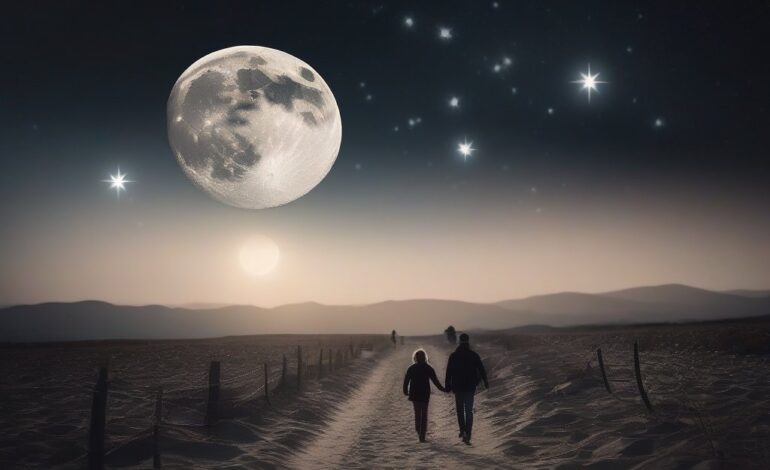Is the Moon a Star?

-
Table of Contents
- Is the Moon a Star?
- Understanding the Moon
- What Are Stars?
- The Differences Between the Moon and Stars
- Common Misconceptions
- Misconception 1: The Moon Shines on Its Own
- Misconception 2: The Moon Is Always Visible at Night
- Misconception 3: The Moon Is a Star Because It Shines
- Conclusion
- Q&A
- 1. Is the Moon a star?
- 2. What is the Moon made of?
- 3. How does the Moon shine?
- 4. Can stars be seen during the day?
- 5. How far is the Moon from Earth?
- 6. Can the Moon support life?
- 7. Are there other moons in the solar system?
- 8. What is the nearest star to Earth?
When we look up at the night sky, we often see a multitude of celestial objects, including stars and the Moon. While it is clear that the Moon is not a planet, many people wonder whether it is a star. In this article, we will explore the nature of the Moon and its distinction from stars, providing valuable insights into the fascinating world of astronomy.
Understanding the Moon
The Moon is Earth’s only natural satellite, orbiting around our planet at an average distance of about 238,855 miles (384,400 kilometers). It is the fifth-largest moon in the solar system and has a diameter of approximately 2,159 miles (3,474 kilometers). The Moon’s surface is covered in craters, mountains, and plains, and it lacks an atmosphere and liquid water.
What Are Stars?
Stars, on the other hand, are luminous celestial bodies made up of hot gases, primarily hydrogen and helium. They generate energy through nuclear fusion, where hydrogen atoms combine to form helium, releasing a tremendous amount of energy in the process. This energy is what makes stars shine brightly in the night sky.
The Differences Between the Moon and Stars
While the Moon and stars are both visible in the night sky, they have several fundamental differences:
- Composition: The Moon is primarily composed of rock and metal, while stars are made up of hot gases.
- Light: The Moon reflects sunlight, which is why it appears bright in the night sky. Stars, on the other hand, emit their own light due to the energy generated through nuclear fusion.
- Size: The Moon is much smaller than stars. In fact, it is only about one-fourth the size of Earth. Stars, on the other hand, can vary greatly in size, with some being much larger than our Sun.
- Distance: The Moon is relatively close to Earth, while stars are located at vast distances from our planet. The nearest star to Earth, apart from the Sun, is Proxima Centauri, which is about 4.24 light-years away.
Common Misconceptions
Despite these differences, there are still some common misconceptions that lead people to believe the Moon is a star. Let’s address a few of these misconceptions:
Misconception 1: The Moon Shines on Its Own
As mentioned earlier, the Moon reflects sunlight, which is why it appears bright in the night sky. However, some people mistakenly believe that the Moon generates its own light. This misconception may arise from the fact that stars emit their own light, leading to confusion between the two celestial objects.
Misconception 2: The Moon Is Always Visible at Night
While the Moon is often visible at night, it is not always present in the sky. The Moon goes through different phases, such as the new moon, first quarter, full moon, and last quarter. During certain phases, the Moon may not be visible at all, depending on its position relative to the Sun and Earth. Stars, on the other hand, are visible throughout the night, regardless of the Moon’s presence.
Misconception 3: The Moon Is a Star Because It Shines
Shining in the night sky does not necessarily make an object a star. Many other celestial objects, such as planets and satellites, can also appear bright in the night sky. The Moon’s brightness is due to its reflective properties, not its ability to generate light through nuclear fusion like stars.
Conclusion
In conclusion, the Moon is not a star but rather Earth’s natural satellite. While it shares the night sky with stars, the Moon differs significantly in composition, light source, size, and distance from stars. Understanding these differences helps us appreciate the vastness and diversity of the universe. So, the next time you gaze up at the night sky, remember that the Moon is not a star, but a fascinating celestial object in its own right.
Q&A
1. Is the Moon a star?
No, the Moon is not a star. It is Earth’s natural satellite.
2. What is the Moon made of?
The Moon is primarily composed of rock and metal.
3. How does the Moon shine?
The Moon shines by reflecting sunlight.
4. Can stars be seen during the day?
Yes, stars are present in the sky during the day, but they are often not visible due to the brightness of the Sun.
5. How far is the Moon from Earth?
The average distance between the Moon and Earth is about 238,855 miles (384,400 kilometers).
6. Can the Moon support life?
No, the Moon does not have an atmosphere or liquid water, making it inhospitable for life as we know it.
7. Are there other moons in the solar system?
Yes, there are numerous moons in the solar system. For example, Jupiter, the largest planet, has 79 known moons.
8. What is the nearest star to Earth?
The nearest star to Earth, apart from the Sun, is Proxima Centauri, located about 4.24 light-years away.



